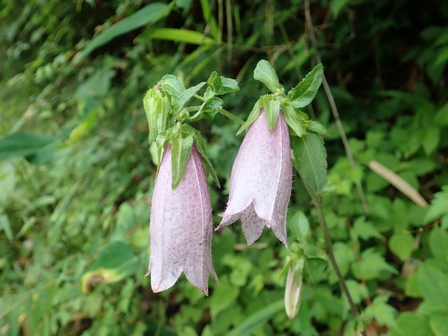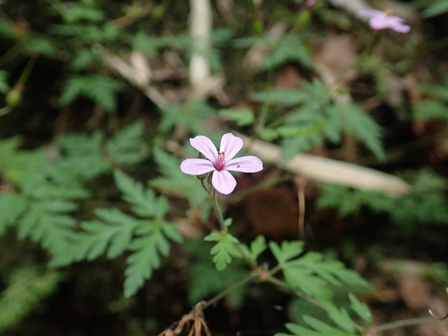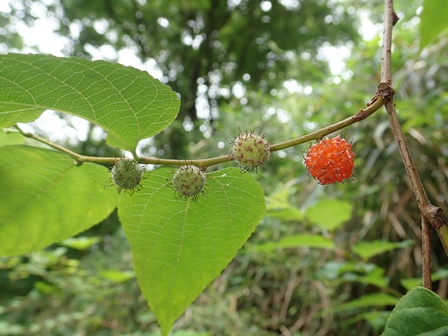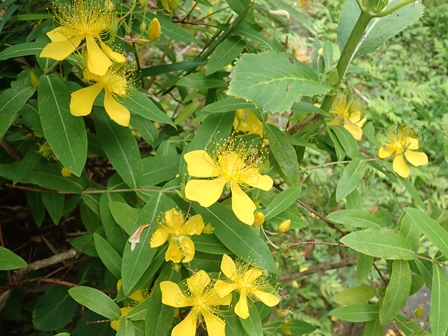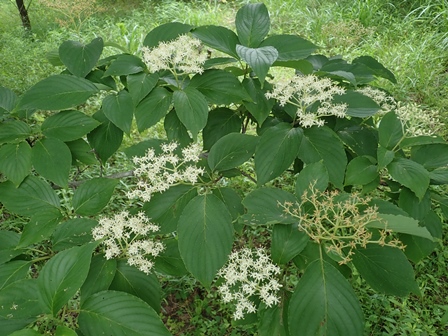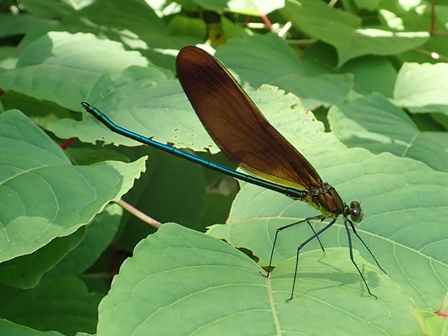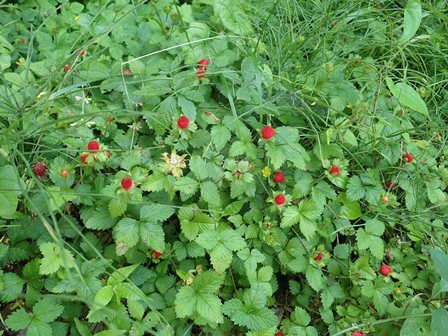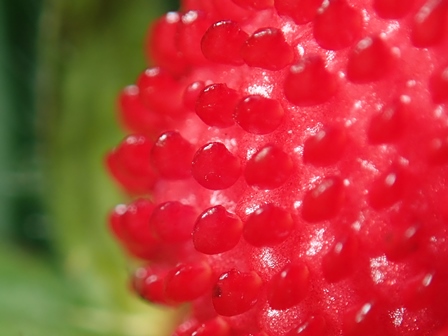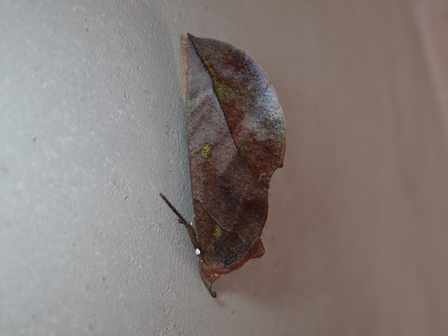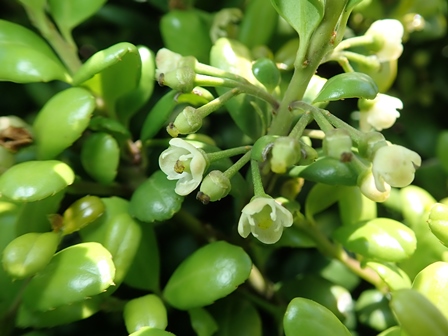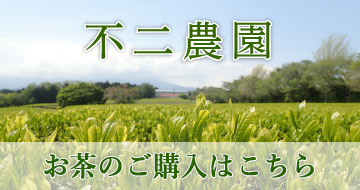フィールド日記
2021年06月
2021.06.29
ホタルブクロ
校舎の裏でホタルブクロが咲いています。和名は、子供たちが釣鐘型の花の中にホタルを入れて遊んだことに由来すると言われています。花の色は白から赤紫まで変異があります。花の内側には紫の斑点があり、外側からも透けて見えます。
"Hotaru-Bukuro (ホタルブクロ)" plants are in bloom behind the school building. The name comes from the fact that children used to play putting fireflies into the bell-shaped flowers. Their flowers have variety of colors from white to red-violet. There are violet spots inside the flowers that are seen through from outside.
2021.06.25
ヒメフウロ
裏道でヒメフウロが咲いていました。日本ではもともと伊吹山など限られた地域でのみ自生していますが、世界的には北半球の温帯に広く分布しています。近年、園芸用に国外から持ち込まれたものが逸出し、道端などでよく見かけるようになったようです。この個体も本来の自生ではなく、園芸品の逸出と考えられます。
"Hime-Fuuro (ヒメフウロ)" plants are in bloom on the back road. In Japan, they originally grow in limited areas like Mt.Ibuki while, globally, they widely grow in the regions of temperate climate on the Northern hemisphere. These days, those brought for gardening from abroad escape to the nature and "Hime-Fuuro (ヒメフウロ)" are often seen on roadsides. This one in the photo doesn't seem to have originally lived here but escaped from a garden.
2021.06.22
ヒメコウゾ
ヒメコウゾの果実が赤く色づいていました。この実は食用になります。ヒメコウゾの樹皮はかつて和紙の原料として用いられたそうです。
"Himekouzo (ヒメコウゾ)" fruits are turning red. They are edible. Their bark was once used to make Japanese paper.
2021.06.18
ビヨウヤナギ
聖心坂でビヨウヤナギが咲いています。中国原産で17世紀に渡来したと言われています。花が美しいため、よく庭などに植えられています。ヤナギと名前がついていますが、ヤナギの仲間ではなくオトギリソウの仲間です。
"Biyou-Yanagi (ビヨウヤナギ)" trees are in bloom in the "Seishin Zaka(聖心坂)". They came from China in 17th century. They bloom beautiful flowers so they are often planted in gardens. They are called "Yanagi (ヤナギ)", but they are not related to "Yanagi (ヤナギ)" trees. Rather, they are a close relative species to "Otogirisou (オトギリソウ)" plants.
2021.06.15
クマノミズキ
共生の森でクマノミズキが咲いています。花は近縁のミズキととてもよく似ていますが、クマノミズキは葉が1か所から2枚出る対生で、ミズキは葉が互い違いに出る互生です。また花期もクマノミズキのほうが1か月ほど遅いため、見分けるのは容易です。
2021.06.11
ミヤマカワトンボ
裏道でミヤマカワトンボを見つけました。名前の通り、丘陵地や山地の渓流などに生息しています。体は金属光沢のある青緑色で、とてもきれいです。また、翅は茶色で、先端付近に濃い褐色の帯があるのが特徴です。
I found a "Miyama-Kawatonbo (ミヤマカワトンボ)" dragonfly on the back road. The name indicates that they live along the streams in mountains and hills. Their body is shiny blue-green and so beautiful. Their brown wings have a dark stripe on the tip.
2021.06.08
ヤブヘビイチゴ
裏道でヤブヘビイチゴの赤い実が成っています。ヘビイチゴに比べ、全体に大型で、実は2cmほどもあります。しかし、食べてもおいしくないそうで、食用にはなりません。
ヤブヘビイチゴの赤い実は偽果と呼ばれ、実際の果実は実の表面についている粒々です。果実の表面が平滑で光沢があることもヘビイチゴと区別するときの特徴になります。
I found many fruits of "Yabu-Hebiichigo (ヤブヘビイチゴ)" plants on the back road. Thay are generally larger than "Hebiichigo (ヘビイチゴ)" plants and their fruits are about 2cm in size. However, the fruits are not tasty so they are not edible. Their fruits are botanically called 'accessory fruits' and their real fruits are the grains on the 'accessory fruits'.
You can also tell "Yabu-Hebiichigo (ヤブヘビイチゴ)" plants from "Hebiichigo (ヘビイチゴ)" plants by their smooth and shiny surface of the former.
2021.06.04
アケビコノハ
図書館への渡り廊下の壁でアケビコノハを見つけました。名前は幼虫の食樹がアケビであることに由来します。前翅には葉脈のような模様があり、落ち葉にとてもよく擬態しています。
I found a "Akebi-Konoha (アケビコノハ)" moth on the wall of the crossing corridor to the library. Its name comes from the fact that their larvae eat "Akebi (アケビ)" plants. Their fore wings have leaf-vein patterns and they mimic dead leaves very well.
2021.06.01
マメツゲ
築山でマメツゲの花が咲いています。イヌツゲの品種で、葉の表面が豆のように膨らむのが特徴です。庭などにしばしば植栽されます。花は小さく、ほとんど目立ちませんが、蜜をよく分泌しているようでたくさんの昆虫が訪花していました。
"Mame-Tsuge (マメツゲ)" trees are in bloom in the artificial hill. They are a variety of "Inu-Tsuge (イヌツゲ)", which is characterized by that their rounded leaves like beans. Their flowers are small and not showy but they seem to produce nectar well because lots of insects are visiting them.
- 1 / 1


